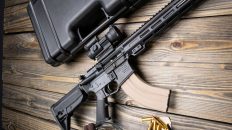When it comes to firearms, the AR-15 is a widely popular choice among gun enthusiasts and professionals alike. Its reliability and versatile performance have made it a staple in the shooting community. However, there is a lesser-known aspect of the AR-15 that directly affects its performance: primer residue.
In this article, we dive into the mysteries surrounding AR-15 primer residue and explore its impact on firearm functionality. From understanding what primer residue is to analyzing its effects on accuracy and reliability, we leave no stone unturned. Whether you’re an avid shooter or just starting out, this knowledge can empower you to make informed decisions about AR-15 maintenance and performance optimization.

Image Source: 5.56×45 NATO Photographic Print by Old World Records.
What is primer residue and how does it impact AR-15 performance
Primer residue refers to the byproduct left behind after a cartridge is fired in the AR-15. It is primarily composed of unburned or partially burned primer compounds, such as lead styphnate, barium nitrate, and antimony sulfide commonly used as fuel in primers. As the primer ignites, it creates a small explosion that ignites the propellant powder, propelling the bullet forward. However, not all of the primer compounds fully combust, resulting in residue buildup within the firearm.
The presence of primer residue can have a significant impact on AR-15 performance. One of the key ways it affects functionality is by impeding the cycling of the AR-15’s bolt. The residue can accumulate in the firing pin channel and bolt assembly, causing increased friction and potentially leading to malfunctions, such as failure to fully cycle or extract spent casings. This can result in a loss of reliability and can be detrimental in critical situations where quick follow-up shots are necessary.
Moreover, primer residue can also affect the accuracy of the AR-15. As the residue builds up in the barrel, it can alter the dynamics of the bullet’s path, leading to inconsistent bullet placement. This can result in a decrease in overall accuracy, making it challenging to achieve precise shot placement. For competitive shooters or those using the AR-15 for hunting purposes, this can be a significant disadvantage.
Reducing primer residue buildup is essential to maintaining optimal performance. Regular cleaning and maintenance are crucial to preventing excessive residue accumulation, ensuring the AR-15 functions reliably and accurately. In the next section, we will explore the science behind primer residue formation to gain a deeper understanding of its composition and behavior.
For more in-depth information on “what is primer residue”, check out this pGSR (primer gunshot residue) presentation from the Nebraska State Patrol by Amanda Neely, Forensic Laboratory Supervisor – Trace.
The science behind primer residue formation
To understand primer residue, it’s important to have a basic understanding of how the primer functions within a cartridge. When the firing pin strikes the primer, it crushes the primer compound, generating heat and initiating a chemical reaction. This reaction results in the rapid release of gas, which ignites the propellant powder and propels the bullet.
During this process, not all of the primer compounds fully combust. Some compounds, particularly the heavy metal compounds like lead styphnate, may partially burn or undergo incomplete combustion. These partially burned compounds, along with other residue particles, are expelled from the primer pocket (where the primer is seated) and distributed throughout the firearm.
The composition of primer residue can vary depending on various factors, such as the specific primer brand, the quality of the primer mixture, and the ammunition’s overall quality. Different primer brands may use slightly different compounds or ratios, resulting in varying residue characteristics. Additionally, ammunition with higher-quality primers and more consistent compounds tends to produce less residue compared to cheaper or lower-quality options.
The behavior of primer residue within the firearm is also influenced by the specific conditions during firing. Factors such as chamber pressure, barrel length, and the rate of fire can affect the extent of residue formation. Higher chamber pressures or rapid firing can lead to increased residue buildup due to the more intense ignition and combustion process.
Understanding the science behind primer residue formation provides insight into its composition and behavior. This knowledge can help firearm owners make informed decisions regarding ammunition selection, cleaning practices, and overall performance optimization. In the next section, we will address some common misconceptions surrounding primer residue.
Common misconceptions about primer residue
There are several misconceptions and myths surrounding primer residue and its impact on AR-15 performance. Let’s address some of the most common ones:
- Primer residue is harmless and doesn’t affect performance: While primer residue may not pose an immediate danger to the shooter, it can have a significant impact on your firearm’s functionality and accuracy. Excessive residue buildup can lead to malfunctions and decreased accuracy, compromising the overall performance of the AR-15.
- Cleaning the barrel is enough to remove primer residue: While cleaning the barrel is an essential part of firearm maintenance, primer residue can accumulate in other parts of the AR-15, such as the bolt assembly and firing pin channel. Neglecting these areas can lead to increased friction and malfunctions. A comprehensive cleaning routine that addresses all areas prone to residue buildup is necessary.
- All primer residue is the same: The composition and characteristics of primer residue can vary depending on the ammunition used. Different primer brands and mixtures can result in varying residue properties, including color, consistency, and ease of removal. Understanding these differences can help firearm owners select ammunition that produces less residue or is easier to clean.
- Primer residue only affects semi-automatic firearms: While primer residue can have a more noticeable impact on semi-automatic firearms due to their cycling mechanisms, it can still affect the functionality and accuracy of bolt-action or single-shot firearms. Residue buildup can impede extraction and alter bullet path dynamics, leading to reliability and accuracy issues.
By dispelling these misconceptions, firearm owners can better understand the importance of managing primer residue and take appropriate measures to optimize firearm performance. In the following section, we will explore the effects of primer residue on accuracy and reliability in more detail.
Effects of primer residue on accuracy and reliability
Primer residue can have a significant impact on both the accuracy and reliability of the AR-15. Let’s examine these effects in more detail:
- Accuracy: As primer residue accumulates in the barrel, it can create an uneven surface that disrupts the bullet’s trajectory. This can result in inconsistent bullet placement, affecting overall accuracy. Additionally, residue particles can obstruct the rifling, reducing the bullet’s spin and stability, further compromising accuracy.
- Reliability: Excessive primer residue buildup can impede the smooth cycling of the AR-15’s bolt. As the firing pin channel and bolt assembly become contaminated, friction increases, potentially causing malfunctions such as failure to extract or failure to fully cycle. This compromises the firearm’s reliability, especially in situations where quick follow-up shots are necessary.
To mitigate these effects, regular cleaning and maintenance are crucial. A comprehensive cleaning routine should include not only the barrel but also the bolt carrier group, firing pin channel, and other areas prone to residue accumulation. By keeping these areas clean and free from excessive residue buildup, firearm owners can ensure optimal accuracy and reliability.
In addition to proper cleaning practices, ammunition selection plays a crucial role in managing primer residue. Let’s explore this further in the next section.
Cleaning and maintenance tips for reducing primer residue buildup
Proper cleaning and maintenance practices are essential for reducing primer residue buildup and optimizing AR-15 performance. Here are some tips to help firearm owners effectively manage primer residue:
- Regular cleaning: Develop a cleaning routine that includes both the barrel and the bolt carrier group. Use appropriate cleaning solvents and brushes to remove residue from these areas. Pay special attention to the firing pin channel and other small crevices where residue can accumulate.
- Inspect and replace worn parts: Regularly inspect the bolt carrier group and firing pin for signs of wear or damage. Worn or damaged parts can increase friction and hinder proper functioning. Replace any worn bcg parts to ensure optimal performance.
- Use quality ammunition: High-quality ammunition tends to produce less primer residue compared to cheaper or lower-quality options. Consider using reputable brands known for their consistent primer mixtures. This can help reduce the amount of residue buildup and make cleaning easier.
- Consider alternative primer types: Some primer types, such as lead-free or low-residue primers, are specifically designed to minimize residue buildup. These primers can be a viable option for those seeking to reduce the impact of primer residue on firearm performance.
By incorporating these cleaning and maintenance tips into your AR-15 care routine, you can effectively manage primer residue buildup and optimize your firearm’s performance. However, it’s important to note that proper ammunition selection also plays a crucial role. Let’s explore the impact of primer type on residue formation in the next section.
Understanding the role of primer type in residue formation
The type of primer used in ammunition can influence the amount and characteristics of the residue formed. Different primer types, such as Boxer or Berdan primers, can have varying compositions and properties, affecting residue formation. However, it’s important to note that the primer type alone is not the sole factor determining residue buildup.
Boxer primers, commonly used in AR-15 ammunition, typically produce more residue compared to Berdan primers. This is mainly because Boxer primers have a larger flash hole, allowing more primer compounds to escape into the firearm. The larger flash hole can also lead to increased primer flow, resulting in more residue formation. However, other factors, such as the primer mixture’s quality and the ammunition’s overall construction, can also impact residue formation. For a detailed comparison between Boxer and Berdan primers, check out this Berdan vs Boxer Primed Ammo article from Ammo.com.
While primer type can influence residue buildup, firearm owners should prioritize proper cleaning and maintenance practices to manage primer residue effectively. Regardless of the primer type, regular cleaning routines and proper ammunition selection are crucial for optimizing performance and longevity.
Exploring the impact of primer residue on firearm longevity
In addition to its effects on performance, primer residue can also impact the longevity of your AR-15. Excessive residue buildup can lead to increased friction and wear on critical components, potentially shortening their lifespan. The accumulation of residue particles can also attract moisture, increasing the risk of corrosion and rust formation.
To ensure the longevity of your firearm, it is essential to implement a comprehensive cleaning and maintenance routine. Regularly inspect critical components for signs of wear or damage, and promptly replace any worn parts. By managing primer residue buildup and keeping your AR-15 in optimal condition, you can extend its lifespan and enjoy reliable performance for years to come.
Conclusion: Best practices for managing primer residue and optimizing firearm performance
Understanding the impact of primer residue on AR-15 performance is essential for firearm owners who seek to optimize their firearm’s functionality and accuracy. By implementing the following best practices, you can effectively manage primer residue buildup and ensure optimal firearm performance:
- Regular cleaning and maintenance: Develop a cleaning routine that addresses all areas prone to primer residue accumulation. Clean the barrel, bolt carrier group, firing pin channel, and other critical components regularly to prevent excessive buildup, including carbon buildup.
- Inspect and replace worn parts: Regularly inspect critical components for signs of wear or damage. Replace any worn or damaged parts to maintain optimal performance and reliability.
- Use quality ammunition: Select ammunition from reputable brands known for their consistent primer mixtures. High-quality ammunition tends to produce less residue and can contribute to easier cleaning and improved performance.
- Consider alternative primer types: Explore the option of using low-residue or lead-free primers, which are specifically designed to minimize residue buildup. These primers can be beneficial for those seeking to reduce the impact of primer residue on firearm performance.
By following these best practices, you can effectively manage primer residue and unlock the full potential of your AR-15. Don’t let the mysteries of primer residue hold you back from achieving optimal performance – take control of your firearm maintenance and enjoy the rewards of reliable accuracy and functionality.





Add comment